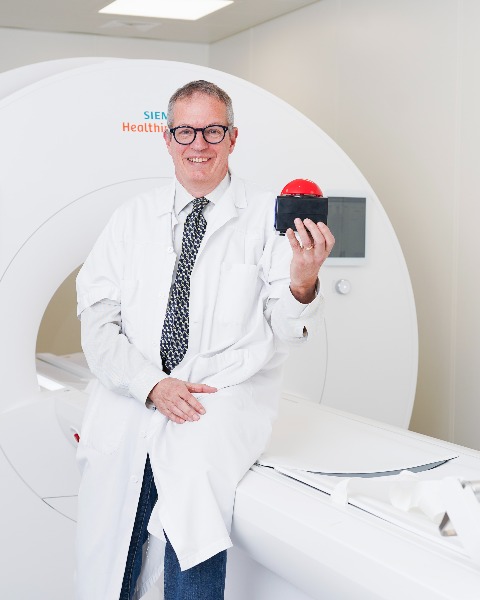Rapid Fire Abstracts
One-shot black-blood late gadolinium enhancement imaging for rapid, motion-free, and diagnostically accurate scar imaging (RF_FR_319)
- Vd
Victor de Villedon de Naide, MSc
PhD student
Bordeaux University - INSERM U1045, France - Vd
Victor de Villedon de Naide, MSc
PhD student
Bordeaux University - INSERM U1045, France - KN
Kalvin Narceau, MSc
Research Engineer
Bordeaux University - INSERM U1045, France - bd
baptiste durand, MD, PhD
Radiologist
Department of Cardiovascular Imaging, Hôpital Cardiologique du Haut-Lévêque, CHU de Bordeaux, Avenue de Magellan, 33604 Pessac, France, France 
Thomas Kuestner, PhD, MSc
Professor
Medical Image and Data Analysis (MIDAS.lab), Department of Diagnostic and Interventional Radiology, University Hospital of Tübingen, 72076 Tübingen, Germany, Germany- PG
Pauline Gut, MSc
PhD student
University Hospital (CHUV) and University of Lausanne (UNIL), Switzerland - MV
Manuel Villegas-Martinez, PhD
Postdoctoral Student
Bordeaux University - INSERM U1045, France - tG
thais Génisson, MSc
PhD student
IHU LIRYC, Heart rhythm disease institute, Université de Bordeaux – INSERM U1045, Avenue du Haut Lévêque, 33604, Pessac, France, France - TR
Théo Richard, MSc
Engineer
IHU LIRYC, Heart rhythm disease institute, Université de Bordeaux – INSERM U1045, Avenue du Haut Lévêque, 33604, Pessac, France, France - PJ
Pierre Jaïs, MD, PhD
PROF/PhD
Hôpital Cardiologique du Haut-Lévêque, CHU de Bordeaux, France 
Mathias Stuber, PhD
Full Professor
CIBM-CHUV-UNIL
Laussane University, Switzerland- HC
Hubert Cochet, MD, PhD
Professor
Department of Cardiovascular Imaging, Hôpital Cardiologique du Haut-Lévêque, CHU de Bordeaux, France 
Aurelien Bustin, PhD
Assistant Professor
IHU LIRYC, France
Presenting Author(s)
Primary Author(s)
Co-Author(s)
Black-blood late gadolinium enhancement (LGE) imaging has emerged as a valuable tool for the non-invasive assessment of myocardial injuries, particularly in cases of subendocardial myocardial infarction where conventional bright-blood imaging techniques fall short due to poor scar-blood contrast1,2. Although effective, these methods are time-consuming, require multiple breath-holds, and are prone to residual motion artifacts.
Here, we introduce a free-breathing one-shot black-blood LGE sequence combined with image denoising, to provide rapid, motion-free, and diagnostically accurate scar imaging for patients with myocardial infarction.
Methods:
Multi-shot sequence: A black-blood 2D whole-heart ECG-triggered sequence acquires multiple single-shot LGE short-axis images per slice using a non-selective 180° inversion pulse, followed by a preparation module (T1-rho, T2, or MTC)3. A dummy heartbeat is added between shots to allow for magnetization recovery. The single-shot images are then averaged to enhance quality3.
One-shot sequence: The proposed one-shot PROST sequence eliminates magnetization recovery time, though reducing the signal-to-noise ratio. A patch-based low-rank denoising algorithm (PROST)4 compensates, achieving multi-shot image quality (Fig.1).
Experiments: 19 patients (3 females, age 28-73yo) with ischemic heart disease underwent 1.5T CMR (Siemens Aera) using reference breath-held 2D PSIR5 and five-shot black-blood imaging 12min after gadolinium injection (in random order). One-shot images were retrospectively selected from multi-shot datasets and then PROST-denoised. Imaging parameters were: 3-18 slices, 1.5x1.5mm2 in-plane resolution, 8mm slice thickness, black-blood T1-rho prep, spin-lock frequency/duration=500Hz/27ms, FA=60º, GRAPPA x2, ~160ms acquisition window, TE/TR=1.2/2.8ms, bandwidth=870Hz/pixel, inversion time from prior scout.
Analysis: A blinded radiologist graded diagnostic confidence (0:non-diagnostic, 3:excellent), documented dataset with the presence of residual motion artefact, and extracted scar volume and signal intensities (blood, scar, remote myocardium) using Circle CVI42. Scar volume agreement was evaluated using ICC (95% confidence intervals) and Bland-Altman analysis (bias±standard deviation).
Results:
Acquisition times were 4min23sec±78sec, 4min24sec±73sec, and 29sec±8sec (P< 0.001, Kurskal-Wallis) for PSIR, black-blood multi-shot and one-shot PROST, respectively. Example images from four patients are shown in Fig.2. No statistically significant differences were observed in signal intensities between black-blood multi-shot and one-shot PROST (P=0.732, two-way ANOVA), or in scar detection (P=0.663, Chi-squared). Diagnostic confidence scores were rated as good (score 2) in 63% of cases for both sequences, and excellent (score 3) in 32% of black-blood multi-shot and 26% of one-shot PROST scans. Residual motion artefacts were found in 4 (21%), 3 (16%), and 0 (0%) of the PSIR, black-blood multi-shot, and black-blood one-shot PROST datasets, respectively. Scar volume agreement between black-blood multi-shot and one-shot PROST was excellent (ICC=0.96, 95%CI [0.89;0.98], bias +1.3mL±6.8, Fig.3).
Conclusion:
The proposed black-blood LGE one-shot PROST sequence provides rapid, motion-free, and diagnostically accurate scar imaging, offering a more efficient and patient-friendly solution for patients with myocardial infarction. Prospective testing is now warranted.

